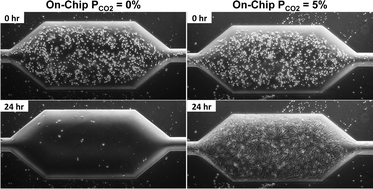On-chip CO2 control for microfluidic cell culture†
Abstract
Carbon dioxide partial pressure (PCO2) was controlled on-chip by flowing pre-equilibrated aqueous solutions through control channels across the device. Elevated PCO2 (e.g. 0.05 atm) was modulated in neighboring stagnant channels via equilibration through the highly gas permeable substrate, poly(dimethylsiloxane) (PDMS). Stable gradients in PCO2 were demonstrated with a pair of control lines in a source-sink configuration. PCO2 equilibration was found to be sufficiently rapid (minutes) and stable (days) to enable long-term microfluidic culture of mammalian cells. The aqueous solutions flowing through the device also mitigated pervaporative losses at sustained elevated temperatures (e.g. 37 C), as compared to flowing humidified gas through the control lines to control PCO2. Since


 Please wait while we load your content...
Please wait while we load your content...